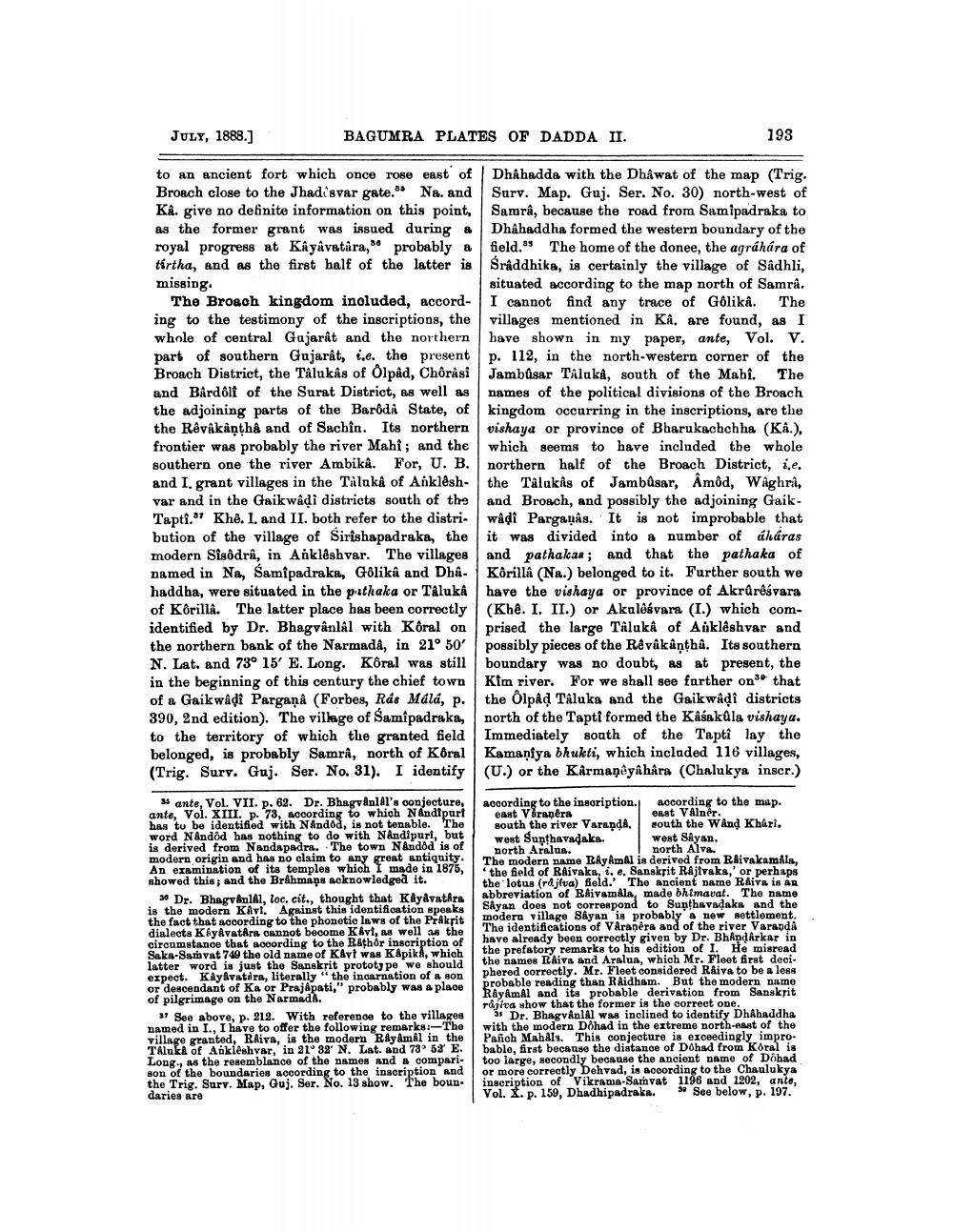________________
JULY, 1888.]
to an ancient fort which once rose east of Broach close to the Jhadisvar gate. Na. and Kâ. give no definite information on this point, as the former grant was issued during a royal progress at Kâyâvatara, probably a tirtha, and as the first half of the latter is missing.
36
The Broach kingdom included, according to the testimony of the inscriptions, the whole of central Gujarât and the northern part of southern Gujarât, i.e. the present Broach District, the Tâlukâs of Ôlpâd, Chôrâsî and Bârdôlf of the Surat District, as well as the adjoining parts of the Baroda State, of the Rêvâkantha and of Sachîn. Its northern frontier was probably the river Mahi; and the southern one the river Ambikâ. For, U. B. and I. grant villages in the Talukâ of Anklêshvar and in the Gaikwadi districts south of the Tapti." Khê. I. and II. both refer to the distribution of the village of Sirishapadraka, the modern Sisôdrâ, in Anklêshvar. The villages named in Na, Samipadraka, Golika and Dhâhaddha, were situated in the pathaka or Taluka of Kôrilla. The latter place has been correctly identified by Dr. Bhagvânlâl with Kôral on the northern bank of the Narmada, in 21° 50' N. Lat. and 73° 15′ E. Long. Kôral was still in the beginning of this century the chief town of a Gaikwadi Pargana (Forbes, Rás Málá, p. 390, 2nd edition). The village of Samîpadraka, to the territory of which the granted field belonged, is probably Samrâ, north of Kôral (Trig. Surv. Guj. Ser. No. 31). I identify
BAGUMRA PLATES OF DADDA II.
35 ante, Vol. VII. p. 62. Dr. Bhagvanlal's conjecture, ante, Vol. XIII. p. 73, according to which Nandipurt has to be identified with Nandod, is not tenable. The word Nandod has nothing to do with Nandipuri, but is derived from Nandapadra. The town Nandod is of modern origin and has no claim to any great antiquity. An examination of its temples which I made in 1875, showed this; and the Brahmans acknowledged it.
30 Dr. Bhagvanlal, loc. cit., thought that Kayavatara is the modern Kivi. Against this identification speaks the fact that according to the phonetic laws of the Prakrit dialects KayAvatara cannot become Kivi, as well as the circumstance that according to the R&thor inscription of Saka-Samvat 749 the old name of Kavt was Kapika, which latter word is just the Sanskrit prototype we should expect. Kâyâvatera, literally "the incarnation of a son or descendant of Ka or Prajapati," probably was a place of pilgrimage on the Narmada.
37 See above, p. 212. With reference to the villages named in I., I have to offer the following remarks:-The village granted, Riva, is the modern Râyâmil in the Taluka of Anklêshvar, in 21° 32' N. Lat. and 73° 52' E. Long., as the resemblance of the names and a comparison of the boundaries according to the inscription and the Trig. Surv. Map, Guj. Ser. No. 13 show. The boun daries are
193
Dhâhadda with the Dhâwat of the map (Trig. Surv. Map. Guj. Ser. No. 30) north-west of Samrâ, because the road from Samipadraka to Dhâhaddha formed the western boundary of the field. The home of the donee, the agráhára of Śrâddhika, is certainly the village of Sâdhli, situated according to the map north of Samrâ. I cannot find any trace of Gôlikâ. The villages mentioned in Kâ. are found, as I have shown in my paper, ante, Vol. V. p. 112, in the north-western corner of the Jambusar Taluka, south of the Mahî. The names of the political divisions of the Broach kingdom occurring in the inscriptions, are the vishaya or province of Bharukachchha (Kâ.), which seems to have included the whole northern half of the Broach District, i.e. the Talukâs of Jambusar, Âmôd, Waghra, and Broach, and possibly the adjoining Gaikwadi Parganas. It is not improbable that it was divided into a number of áháras and pathakas; and that the pathaka of Kôrillâ (Na.) belonged to it. Further south we have the vishaya or province of Akrûrêsvara (Khê. I. II.) or Akulêśvara (I.) which comprised the large Taluk of Anklêshvar and possibly pieces of the Rêvâkânțhâ. Its southern boundary was no doubt, as at present, the Kim river. For we shall see further on that
the Ôlpad Taluka and the Gaikwaḍî districts north of the Tapti formed the Kâsakula vishaya. Immediately south of the Tapti lay the Kamaniya bhukti, which included 116 villages, (U.) or the Karmanêyâhâra (Chalukya inscr.)
according to the inscription. east Varanera
west Sayan. north Alva.
derived from Raivakamála,
south the river Varaṇḍa. west Sunthavadaka. north Aralus. The modern name RAyAmal is the field of Raivaka, i. e. Sanskrit Rajivaka,' or perhaps the lotus (rajiva) field.' The ancient name Raiva is an abbreviation of Raivamala, made bhimavat. The name Sayan does not correspond to Sunthavadaka and the modern village Sayan is probably a new settlement. The identifications of VAranêra and of the river Varanda have already been correctly given by Dr. Bhandarkar in the prefatory remarks to his edition of I. He misread the names Raiva and Aralua, which Mr. Fleet first deciphered correctly. Mr. Fleet considered Râiva to be a less probable reading than Raidham. But the modern name RayAmal and its probable derivation from Sanskrit rajita show that the former is the correct one.
3s Dr. Bhagvanlal was inclined to identify Dhâhaddha with the modern Dohad in the extreme north-east of the Pañch Mahals. This conjecture is exceedingly improbable, first because the distance of Dohad from Kóral is too large, secondly because the ancient name of Dohad or more correctly Dehvad, is according to the Chaulukya inscription of Vikrama-Samvat 1196 and 1202, ante, Vol. X. p. 159, Dhadhipadraka. sa See below, p. 197.
according to the map. east Vilner.
south the Wand Khari.




